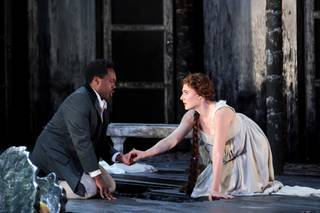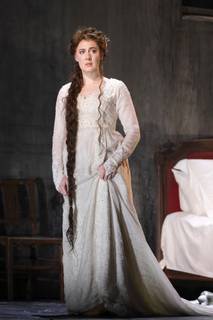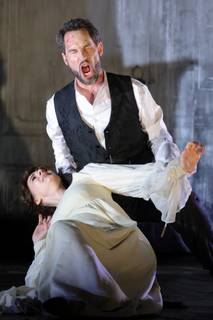|
Back
Beautifully nuanced Los Angeles
Dorothy Chandler Pavilion
03/25/2023 - & 2, 5, 8, 13, 16 April 2023
Claude Debussy: Pelléas et Mélisande
Will Liverman (Pelléas), Sydney Mancasola (Mélisande), Kyle Ketelsen (Golaud), Ferruccio Furlanetto (King Arkel), Susan Graham (Geneviève), Kai Edgar (Yniold), Patrick Blackwell (a physician)
Los Angeles Opera Chorus, Jeremy Frank (chorus master), Los Angeles Opera Orchestra, Roberto Cani (concertmaster), James Conlon (conductor)
David McVicar (production), Leah Hausman (stage director/movement), Rae Smith (scenery and costume designer), Paule Constable (lighting designer), Jack Henry James Fox (projections) 
W. Liverman, S. Mancasola (© Craig T. Mathew)
On January 27, 2019 the wheels began turning with Los Angeles Opera’s (LAO) announcement of their 2019/2020 season. While continuous successes hit early on in the season, a premonition soon surfaced with the tumultuous hit of Donizetti’s Roberto Devereux that shortly led to the sudden closure of The Dorothy Chandler due to the COVID outbreak, including Claude Debussy’s enigmatic drame lyrique: it hadn’t been seen since 1995. But there was a gut feeling that this story was far from over, especially since James Conlon wrote his 2020 “Wistful Letter” and the imminent return of Pelléas et Mélisande in the near future.
Back in the 19th century the stars were aligned, and they prevailed during the connection between Claude Debussy and dramatist Maurice Maeterlinck. This so called “dream of destiny” would unravel itself, once again, for conductor James Conlon who speaks fondly and passionately of Pelléas et Mélisande: it’s a mere reflection on William Langland’s “Patience is a virtue” coined phrase.
David McVicar’s lens has been felt far and wide and as early as 2004 for LAO when he debuted his Idomeneo and a tastefully satirical Holgarth‑esque draw surrounding Chicago Lyric Opera’s 2008 Manon. The current Pelléas et Mélisande is anchored in tasteful tradition: Rae Smith’s dank and off gray voluminous interiors are ensconced by mossy and anticipatory petrichor wafting outside the castle walls that’s accentuated by Paule Constable’s capricious luminescences which flutter away with pinpoint dexterity against the impressionistic notes. While other directors set Debussy’s music in virtual, unrelenting “slow motion”, Leah Hausman peels back expected sedentary clauses and stretches forward with modicums of mouvement de bon goût. All in all, choreography, combined by James Conlon’s fastidious and delicate reading of Debussy, create an orb of unrivalled splendor.

S. Mancasola (© Craig T. Mathew)
Mlle Hausman’s Pelléas et Mélisande issues polite blocking and movement: no rough edges prevail. Debuting Sydney Mancasola molds Mélisande with demure and humility while the slightly deeper soprano timbre pulls forth a more consoling atmosphere. She upholds the qualities of the eponymous female with tasteful ambiguity and stately domain. As the counterpart, Will Liverman’s baritone voice exudes resolute control, though the acting tends to be a bit stiff. “America’s favorite mezzo” and now the Artistic Advisor of the Domingo-Colburn-Stein Young Artist Program, Susan Graham slips into a tastefully designed Rae Smith Victorian costume, bringing her Geneviève as a consoling and empathetic interlocutor.

K. Ketelsen, S. Mancasola (© Craig T. Mathew)
The authoritative bass voice surrounding Ferruccio Furlanetto hasn’t lost any of its majestic armor, after delivering intoxicating portrayals of Don Carlo’s King Phillip II in 2008 and 2018. King Arkel is given a firm stature and broad authority as he maneuvers control of his kingdom of Allemonde and the upheavals within his domain. But all eyes turn to the blistering animation and virile might expressed by Kyle Ketelsen: his Golaud is slow to burn, edgy, grumbling, irascible and laden with jealous rage as he races to the finish line with his bed‑ridden Mélisande sprawled out in Act V. More might and strength is directed inside this individual; therefore, it demonstrates the importance of this mighty bass‑baritone voice as the driving force to unleash the mysterious forces pushing and pulling inside this Pelléas et Mélisande. Footnoted, Kai Edgar’s Yniold treble articulation is spot‑on, adding to the building drama that crests in Act III.
The devotion, affection and appreciation James Conlon reflects towards Pelléas et Mélisande is fitting and heartfelt. While the Los Angeles Opera Orchestra is yet another “witness to action”, a musical narration which “fills in the blanks”, it completes the opera as a whole and contributes supreme symbolist textures. M. Conlon delivers beautiful nuances and delicate touches to such an unusual yet brilliantly evocative score.
Pelléas et Mélisande is superb and highly recommended.
Christie Grimstad
|